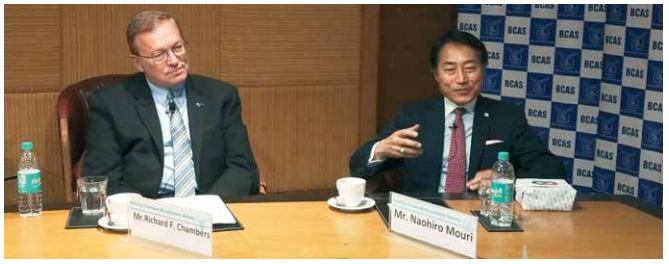Yoshio Kubo vs. CIT; [2013] 36 taxmann.com 1 (Delhi)
The
assessees were employees of a foreign company who were seconded to
India to serve in the Indian subsidiary. The foreign employers bore the
tax arising in India on the income of the employees. The foreign
employer also made contributions towards social security, pension and
medical insurance in compliance with the legal requirements in the
country of its incorporation. The revenue sought to bring to tax such
contributions as well as the tax paid by the employer as perquisite u/s.
17(2), in the hands of the employees. The revenue also contended that
the tax borne by the employer was a monetary perquisite and further tax
should be added to the salary by a multiple stage grossing up process.
The revenue also included the tax refunds in the income of the assessee
employees, as the tax had been borne by the employer.
In appeals
before the High Court the assessee contended that such perquisites were
exempt u/s. 10(10CC). The Delhi High Court held as under:
”1. Whether income tax paid by employer on behalf of assessee was exempted non-monetary perquisite:
1.1
A plain reading of section 10(10CC) reveals that if the perquisite that
is – ‘not provided for by way of monetary payment’ – u/s. 17 (2), the
tax paid on such income would be excluded from the calculation of income
altogether; it would not be deemed a perquisite.
1.2 Section
17(2) has not undergone any substantial change by the amendment of 2002.
The only change is in the introduction of section 10(10CC) which states
that tax actually paid by the employer to discharge an employee’s
obligation – ‘not amounting to a monetary benefit’ would not be included
as the employees’ income. If seen from the context of section 17(2),
and the previous history to that provision, as well as the pre-existing
provision of section 10(5B) and the interpretation placed on section
17(2), read with other provisions which disallow payments made on behalf
of the employee, by the employer, so long as the benefit is not
expressed in monetary terms in the hands of the employee, in the sense
that it is not funded as part of the salary, but paid in discharge of
the obligation, of any sort, either contractual (i.e., rent, services,
etc . availed of by the employee) or legal (tax) directly by the
employer, it should not be treated as a monetary benefit. The reason for
this is that section 10(10CC) is neutral about the kind of benefit
availed by the employee.
1.3 Parliament was aware of the
pre-existing law, and therefore, stepped in to clarify that only a
monetary benefit directly in the hands of the employee as a payment by
the employer would be excluded from section 10(10CC). This may be in the
form of any benefit to pay rent, or discharge any manner of obligation,
tax not excluded. This intention is manifest from the expression –
‘tax’ on such income actually paid. To construe this newly introduced
provision in any other manner would be to defeat the Parliamentary
intent. Section 40(a)(v) fortifies the interpretation of this court in
providing that while calculating income of the employer, the tax paid by
the employer on non-monetary perquisites is not deductible. This
provision too was introduced in 2002. The logic of excluding, as a
non-monetary perquisite, amounts paid to discharge obligations of the
employee, from the meaning of income, by virtue of section 10(10CC) is
that now, with the introduction of section 40(c)(v), such amounts are
not deductible in the employer’s hands.
1.4 In the light of the
above discussion, it is held that amounts paid directly by the employer
to discharge its employees’ income tax liability do not fall within the
excluded category of monetary benefits payable to the employee; they
fall within the included category, u/s. 10(10CC) as amounts paid
directly as taxes. Correspondingly, they cannot now be claimed as
deductions by virtue of section 40(c)(v ). The revenue’s appeals on this
aspect fail.
2. Whether social security, pension and medical insurance contributions by employer are perquisites:
2.1
The revenue’s contentions are insubstantial and meritless. The assessee
does not get a vested right at the time of contribution to the fund by
the employer. The amount standing to the credit of the pension fund
account, social security or medical or health insurance would continue
to remain invested till the assessee becomes entitled to receive it. In
the case of medical benefit, the revenue could not support its
contentions by citing any provision in any policy or scheme which was
the subject matter of these appeals, where the vesting right to receive
the amount under the scheme or plan occurred. One cannot be said to
allow a perquisite to an employee if the employee has no right to the
same. It cannot apply to contingent payments to which the employee has
no right till the contingency occurs. The employee must have a vested
right in the amount. In the case of CIT vs. Mehar Singh Sampuran Singh
Chawla [1973] 90 ITR 219 (Delhi), it was held that the contribution made
by the employer towards a fund established for the welfare of the
employees would not be deemed to be a perquisite in the hands of the
employees concerned as they do not acquire a vested right in the sum
contributed by the employer.
2.2 When the amount does not result
in a direct present benefit to the employee, who does not enjoy it, but
assures him a future benefit, in the event of contingency, the payment
made by the employer, does not vest in the employee.
2.3 In view
of the above discussion, it is held that the revenue’s appeals have to
fail; amounts paid by employers to pension, or social security funds or
for medical benefits, are not perquisites within the meaning of the
expression, u/s. 17(2)(v), and therefore, the amounts paid by the
employer in that regard are not taxable in the hands of the
employee-assessee.
3. Regarding grossing up:
3.1
It has been discussed and concluded that what is not exempt u/s.
10(10CC), is perquisite in the shape of monetary payment to the
employee. If it is a payment to a third party like payment of taxes to
the government, it would be exempt u/s. 10 (10CC).
3.2 The
Tribunal in the present cases, held that tax paid by the employer on
behalf of the employee is a non-monetary perquisite. In other words,
taxes paid by the employer can be added only once in the salary of the
employee. Thereafter, tax on such perquisites is not to be added again.
3.3
Whenever tax is deposited in respect of a non-monetary perquisite, the
provision of section 10(10CC) applies, thus excluding multiple stage
grossing up. The purpose and intent of introducing the amendment to
section 10(10CC) was to exclude the element of income, which would have
arisen otherwise, as a perquisite, and as part of salary. Once that
stood excluded, and option was given to the employer u/s. 192(1A) to
honour the agreement with the employee, Parliament could not have
intended its inclusion in any other form, even for the purpose of
deduction at source. Doing so would defeat the intent behind section
10(10CC). This court, therefore, answers the question in favour of the
assessee and against the revenue.
4. Regarding assessability of TDS refunds
4.1 In this case, it is clear that the amount was not paid to the employee or due to him, from the employer, according to the terms of the contract governing the relationship. It was paid to the Government, over and above the tax due on the salary. It was not for benefit of the assessee. It never, therefore, bore the characteristic of salary or perquisite. Till assessment was made, the amount could not be refunded to the assessee.
4.2 The revenue’s position overlooks that all receipts are not taxable receipts. Before a receipt is brought to tax, the nature and character of the receipt in the hands of the recipient has to be considered. Every receipt or monetary advantage or benefit in the hands of its recipient is not taxable unless it is established to be due to him. If the amount is not due, the recipient, in this case, the employee is obliged to pay back the sum to the person, to whom it belongs. A perquisite or such amount, to be taxed, should be received under a legal or eq-uitable claim, even contingent.
4.3 The receipt of money or property, which one is obliged to return or repay to the rightful owner, as in the case of a loan or credit, cannot be taken as a benefit or a perquisite. The amounts paid in excess by the employer, and refunded to the employee never belonged to the latter; he cannot be therefore taxed. The question of law is therefore, answered against the revenue, and in favour of the assessees.”









